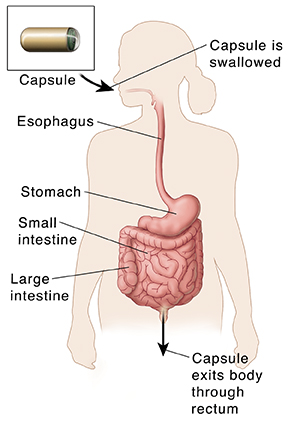Capsule Endoscopy
Capsule endoscopy is a test done to take pictures of the digestive tract. It uses a capsule with a tiny camera in it. The capsule is swallowed like a pill. As it moves through the digestive tract, the camera sends pictures to a recorder worn outside the body. After a few days, the capsule passes out of the body through the rectum during a bowel movement.
Capsule endoscopy is most often done to check for problems in the small bowel (intestine) that are hard to see with a standard endoscopy or colonoscopy. These problems include bleeding and tumors. The test can also help diagnose Crohn’s disease. This is a condition that causes inflammation, sores, and narrowing of the bowel. It can also look for problems caused by celiac disease.
 |
| The capsule is a tiny camera that takes pictures as it moves through the digestive tract. |
Before the test
Tell your healthcare provider about any medicines you're taking. You may need to stop taking some or all of them before the test. This includes:
-
Prescription medicines
-
Over-the-counter medicines, such as aspirin or ibuprofen
-
Illegal drugs
-
Herbs, vitamins, and other supplements
You should also:
-
Tell your provider about any current health conditions and prior surgeries that could prevent the capsule from moving freely through your digestive tract.
-
Switch to a clear liquid diet 16 hours before the test.
-
Stop eating 12 hours before the test.
-
Do a bowel cleansing or use a laxative to clear your bowels, if told to do so by your provider.
-
Follow any other instructions from your provider.
During the test
Depending on your condition, your provider may have you get an imaging test before the capsule endoscopy. Or they may have you swallow a test capsule, which dissolves after a few hours. These steps can help decide if you're at high risk of not passing the capsule.
The capsule endoscopy will be done in a provider’s office or hospital. During the test:
-
You’ll be asked to raise your shirt.
-
You'll most likely have small, sticky, round patches placed on the skin over your belly (abdomen). The patches have antennas that are attached to short wires (leads). The wires are then plugged into a data recorder.
-
The recorder will be attached to a belt worn around your waist. The recorder will be checked to make sure it's working.
-
You’ll be given the capsule to swallow. The capsule will start sending pictures to the recorder. It will keep sending pictures as it moves through your stomach and small bowel.
In rare cases, the capsule may be placed directly in your small bowel, instead of swallowing it. In this case, the provider will insert a thin, flexible tube (endoscope) through your mouth and down into the digestive tract. Your provider will tell you more about this, if needed.
After the test
After you swallow the capsule, you should be able to go home. You can drink clear liquids after 2 hours. You can eat food or take medicine after 4 hours. Be sure to follow any other instructions from your provider. For instance, you may need to avoid some physical activities that could affect your test results.
You should also:
-
Take steps to prevent complications. For instance, don't have an MRI or go near an MRI device until the capsule has passed out of your body.
-
Watch for the capsule to pass out of your body during a bowel movement. It can be flushed down the toilet with your stool. However, you may not see the capsule in the toilet. If the capsule doesn't pass within 3 days, let your provider know right away. You may need to have it removed. Your provider will tell you more about this, if needed.
-
Go back to your provider’s office or the hospital to have the patches and recorder taken off, as instructed by your provider.
Once your provider reviews the pictures, they'll go over the results with you. This is often done within a few days. If the pictures are blurry or unclear, the test may need to be done again.
Risks of the test
There is a chance the capsule won't pass out of your body on its own. This is rare. When this happens, the capsule is most likely stuck in a narrow spot within your bowels (bowel obstruction). Tell your healthcare provider right away if you have any of these:
-
Unusual bloating
-
Abdominal pain
-
Nausea or vomiting
An X-ray can help see if the capsule is still in your body. If it is, you'll need surgery or endoscopy to remove the capsule.